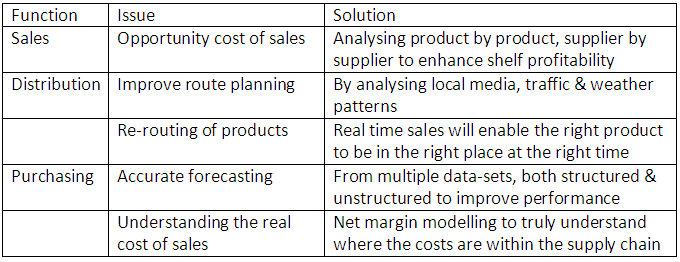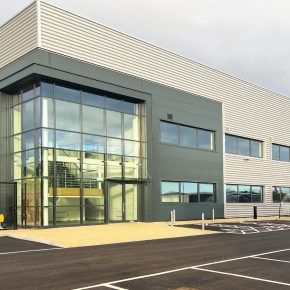
Why Big Data is a big opportunity for the construction industry
Demystifying Big Data and exploring the opportunities in construction
It is estimated that in the UK, better use of Big Data could add £216 billion to the UK economy between 2012 and 2017*. That’s equivalent to 22% of the UK net debt, or more than the 2011 defence, NHS and education budgets combined!
With statistics like these, even with some leeway, the potential opportunities presented by Big Data analysis cannot be ignored by any business. This is particularly so in the construction sector, where there is an acknowledged need for greater collaboration and tough government targets around cost reduction, time to build and sustainability. There has never been a better time or reason to get on board. Huge amounts of data are generated from the initial conception of a project, during the build process, throughout the life time of the construction and its ultimate demolition. Consider the incorporation of external data sets e.g. environmental factors, demographic or geographical information and the idea of Smart Cities becomes an exciting reality.
Key terms
Being a relatively new topic in construction, maybe a good place to start is with a definition of a few of the common key terms, trying to eliminate the jargon and to simplify what is a complex area starting with:-
Big Data
- Definitions vary, but a widely accepted one from Gartner, often referred to as the 3V’s suggests that Big data is high volume, high velocity, and/or high variety information assets that require new forms of processing to enable enhanced decision making, insight discovery and process optimization.
Structured and Unstructured Data
- As the name suggests structured data is managed with a specific set of rules that uniquely classifies each piece of information within a database. A good example is fields on a form capture i.e. first name, last name, DOB this data has structure because the first name field will always be text and DOB will always be a number. However, with unstructured information there is no pre-defined data model and it’s often text heavy data that could include numbers, percentages and dates. Twitter is a perfect example of unstructured data.
Business Intelligence and BigData Solutions
- This is where things get complex and we could talk about how Business Intelligence uses descriptive statistics from data sets with high information density to measure and detect trends whilst Big Data uses inductive statistics and concepts from non-linear system identification to infer laws from large sets of data with low information density. But to keep it simple we like the explanation given by Eric D Brown who said, Business Intelligence helps find answers to questions you know whilst Big Data helps you find the questions you don’t know you wanted to ask.**
Data Warehousing
- Data warehouses are central repositories of data (often structured data) integrated from one or more disparate sources. They store current and historical data and are used in conjunction with analytical and visualisation tools to report on data usually according to defined parameters.
Smart Data
- When we talk about Smart Data we add 2 further dimensions to the Big Data definition provided earlier – Veracity and Value. Smart Data is about filtering out the noise’ around big data, viewing the data in context and creating valuable data that can be used to solve specific business problems with a focus on required outputs, timely action and the creation of something commercially viable.
Progress In Other Sectors
The examples of Big Data analysis are numerous large companies like Amazon and Tesco use Big Data to target customers, attempting to predict what products you are interested in and when you are likely to buy them. Utility companies try to predict if and when you might switch providers and car insurance companies are starting to collect data to better understand how well you drive and to crack down on bogus claims. Police forces use Big Data tools to catch criminals and even predict criminal activity Big Brother is watching you!
However, Big Data is also being used for the common good helping health organisations to find new cures and predict the spread of diseases and ensuring vaccines are in the right place at the right time. The growth in the use of wearable devices to collect blood pressure and heart rate data, lifestyle and other personal data could greatly improve the predictions around life span and wellbeing.
And in the construction press there is much about UK cities starting to use Big Data analytics with the aim of turning themselves into Smart Cities, where a bus would know to wait for a delayed train and where traffic signals can predict traffic volumes and operate to minimise jams.
What does this mean for construction today?
Within construction the big data potential is immense. Building contractors collect vast amounts of data, held in contract bids, construction programmes and supply chain/procurement all of which may yield surprising insight. This is particularly true if data is shared and even compared across different projects, for instance, to see why one project was successful whilst another similar project was over budget and delivered late. Similarly building materials manufacturers collect all types of data about the hundreds and thousands of product lines used during a construction project, all of which is valuable for the owner operator.
However, the biggest challenge is that this information more often than not sits in disparate systems and it is often unstructured. Fortunately Smart Data analytics applications now have the ability to ingest and analyse huge volumes of data in multiple formats from disparate systems. We believe that there are a number of areas where a Smart Data strategy could help significantly and the return on investment could be easily demonstrated, one of these is the construction supply chain.
Here the possibilities are endless, the table below outlines just a few:
| Function | Issue | Solution |
| Sales | Opportunity cost of sales | Analysing product by product, supplier by supplier to enhance shelf profitability |
| Distribution | Improve route planning | By analysing local media, traffic & weather patterns |
| Re-routing of products | Real time sales will enable the right product to be in the right place at the right time | |
| Purchasing | Accurate forecasting | From multiple data-sets, both structured & unstructured to improve performance |
| Understanding the real cost of sales | Net margin modelling to truly understand where the costs are within the supply chain |
What we like about a Smart Data approach is that unlike a data warehousing or BI solution, that can be costly and take a long time to design and implement, with a Smart Data approach you can start small looking at one specific business issue or discrete query at a time, answer it and then build another application to answer the next query and so on. It is much easier to manage cost and the lessons learnt at stage one can be used at the next stage meaning greater flexibility and agility as a result of experience gained.
So how does a Smart Data Application work?
A Smart Data Application provides the tools to help businesses collate, sift and analyse their data. Solutions such as those developed by Anomaly 42 automate the way structured and unstructured data is collected, rationalised, understood, reported and distributed for informed, timely decisions. They are designed to collect data in any format and use automation to create a unique data ecosystem that can be analysed using artificial intelligence algorithms. The outcomes can then be reported in a way that enables companies to understand their data quickly and identify trends and anomalies and most importantly, solve a business problem.
High volumes of data are handled in real-time, automating any data from its native format. Probability and pattern matching is used to fill in quality gaps and any conflicts before the data is extended and enriched to allow dynamic links to be created using visualisation, modelling and scenarios.
There are already companies using applications developed using Anomaly42 tools to analyse invoices. One such example is in telecoms where the client requirement was to analysis a big set of telecoms invoices over varying time periods and claw back overpayments from the carriers.
A system that ingests pdf and electronic telecom invoices, compares them to accounts payable systems and telecom contracts and generates anomalies based on inconsistencies between these data sets.
The tool set contains a search facility to search for any piece of text contained in any document in the system. In addition a slick data cleansing tool displays the original invoice document and the relevant data extracted from each document, allowing data analysts to manage the data from the front end. These tools allow for inventory analysis and data reconciliation and dashboards allow for management of workflows and analysis of cases raised, and monies received relating to these cases.
Following on from this success, Axon is currently developing an application to investigate sub contractor spend, comparing costs across multiple projects and developing benchmarks for pricing and performance of sub-contractors and suppliers.
In addition, building on from other applications developed by Anomaly42 for other sectors, Axon is also developing services to help identify other anomalies, such as fraudulent activity. Interrogation of the payment stream and accounts payable can assist in the identification of altered and fake invoices, inflated prices, suspicious payment descriptions and requestor/approver conflicts.
Axon Data Service’s Smart data solution and analytics tools can unlock data in a real-time environment to provide immediate, predictive analysis at any point within the supply-chain.
The impact of the depth of data analysis available combined with ever-increasing data storage capacity, provides a fascinating opportunity for the construction supply chain. As such, whether you’re a manufacturer, a distributor, architect, contractor, subcontractor or facilities manager, the insights provided by this level of analytics enables new opportunities and a direct contribution to a business’ bottom line.
..
**Eric D Brown, IT consultant and Big Data blogger www.ericdbrown.com
*(Bernard Marr, Forbes 270415)
Latest news

2nd April 2025
FIT Show 2025 Launches Innovative Marketplace Feature to Enhancing Value for Installers
FIT Show, the UK’s leading event for the window, door, flat glass, hardware, and roofing industries, is excited to announce the launch of a brand new Marketplace feature at its upcoming 2025 event (Birmingham NEC, 29 April – 1 May).
Posted in Architectural Ironmongery, Articles, Building Industry Events, Building Industry News, Building Products & Structures, Doors, Exhibitions and Conferences, Glass, Glazing, Hand Tools, Innovations & New Products, Plant, Equipment and Hire, Power Tools, Restoration & Refurbishment, Retrofit & Renovation, Roofs, Seminars, Training, Windows
2nd April 2025
Hi-spec deployment of EJOT Colorfast at new Birmingham logistics park
EJOT Colorfast fasteners have been used extensively in the construction of eight new high-specification warehousing and logistics buildings at the Urban 8 Logistics Park in King’s Norton, Birmingham.
Posted in Articles, Building Industry News, Building Products & Structures, Building Systems, Case Studies, Facades, Restoration & Refurbishment, Retrofit & Renovation, Roofs, Walls
2nd April 2025
SWA member delivers ‘fresh Hope’ for university’s Sustainable Building department
A detailed contract to restore an iconic Art Deco building in the heart of Birmingham’s Jewellery Quarter was carried out by Steel Window Association member, The Window Repair Company (Northwest) Limited.
Posted in Articles, Building Associations & Institutes, Building Industry News, Building Products & Structures, Building Systems, Case Studies, Glass, Glazing, Restoration & Refurbishment, Retrofit & Renovation, Steel and Structural Frames, Sustainability & Energy Efficiency, Windows
1st April 2025
Gilberts Takes Thermal Comfort to New Heights
Gilberts Blackpool is continuing to build on its reputation as a pioneer with the unveiling of ThermaAstute™ – the most extensive range of thermally sensitive diffusers in the market.
Posted in Air Conditioning, Articles, Building Industry News, Building Products & Structures, Building Services, Facility Management & Building Services, Heating, Ventilation and Air Conditioning - HVAC, Innovations & New Products, Restoration & Refurbishment, Retrofit & Renovation, Sustainability & Energy Efficiency
 Sign up:
Sign up: